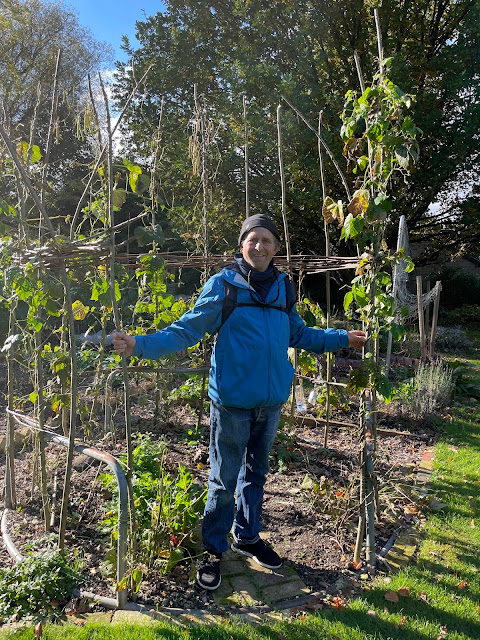I visited the Olivet Heavenly Harvest Garden in the middle of the Coronavirus pandemic on a bright sunny day in June 2020. Punctuating the lively socially distanced conversations taking place was the chop chop sound of ice choppers and spades being used to reduce the size of the compostable material to help speed up the composting process. The raised beds were lush with all types of vegetables, most of which was destined for distribution to local food pantries. This was a necessary change made by the gardeners to safely garden in the time of the pandemic. In 2020, 1650 pounds of vegetables were donated to pantries run by a local Methodist Church, Community Health Action of Staten Island, El Centro, the Refrigerator, The Schoenstatt Sisters of Mary and a soup kitchen at Project Hospitality. This list only highlights the number of people who are food insecure. 
In a normal season, produce is given away each Saturday to people in the community. The gardeners roll out a covered produce stand built by volunteers recruited by Ralph, a young gardener, as his Eagle Scout project. The gardeners don't have to advertise their giveaways. With just word of mouth in the neighborhood, the vegetables are often all given away before the 10 am to 1 pm hours are over. They have regular Saturday visitors including one woman who loves green tomatoes and would always request them. In addition to tomatoes they grew garlic, okra, bok choy, collard greens, lettuce, beans and cucumbers.

Having visited community gardens throughout the US as well as in England and Sweden, I've seen many types of community gardens. The Olivet Heavenly Harvest Garden inspired me more than any other. There is a very active multi-generational group of gardeners here. Many of them are cancer survivors. They are all supportive of each other’s circumstances but from what I saw there were no limits on the work or activities going on.
This winter, when I visited a small group of three of the most active gardeners, Kelly, John and Mike, they rattled off all of the types of cancers represented in their group; colon, liver, prostate, ovarian, breast and skin cancers. They sometimes would see each other at doctor's offices. As Mike told me,"We are good for 6 months until our semi annual checkups" In between doctor visits they spend their time creating an amazing garden.
They have a unique way of organizing the garden. The plots are "rented " to local people who can afford it for $100. The core group of gardeners tend the plots for the renters who will get a head of lettuce or a tomato or two from time to time but the largest share of the produce is donated. This coming season they plan to grow 2000 pounds of produce by utilizing a space to grow onions and potatoes down the block in the backyard of the house used by the minister.
The garden is located on the grounds of Olivet Presbyterian Church on Staten Island. In highly developed cities like New York, very little municipal land is available for planting community gardens, so land owned by churches, mosques or synagogues is being used more and more often. This is a perfect example of that trend.
 The unique characteristics of the space surrounding the church were taken into consideration in the layout of the garden’s plantings and activities. A retaining wall was used for cascading cucumber vines to make use of vertical spaces. Dotting the garden are repurposed pop up awnings minus the shade covering being used as trellises for climbing pole beans. The vegetables are grown within a fenced in area but the gardeners neatly tend the landscaping outside the fence with flowering plantings. One area surrounding the church steps is lovingly tended by Kelly as a Memorial Garden. The garden is also used as a location for plant and tree giveaways sponsored by city agencies and others.
The unique characteristics of the space surrounding the church were taken into consideration in the layout of the garden’s plantings and activities. A retaining wall was used for cascading cucumber vines to make use of vertical spaces. Dotting the garden are repurposed pop up awnings minus the shade covering being used as trellises for climbing pole beans. The vegetables are grown within a fenced in area but the gardeners neatly tend the landscaping outside the fence with flowering plantings. One area surrounding the church steps is lovingly tended by Kelly as a Memorial Garden. The garden is also used as a location for plant and tree giveaways sponsored by city agencies and others.
They spend a bunch of time processing food scraps to be worked into the composting systems they have set up. The chopped up food scraps are composted into the only soil amendment they use on the vegetable plots. In fact they have a bin set up outside the garden gates to accept food scraps 24 hours a day. On the day I visited they were meeting to discuss accepting more food scraps from other collecting sites. The city of New York has unfortunately cut the municipal composting budget by 90%. Community gardeners and other volunteers are pitching in to do the work that should be done by city agencies. The gardeners did not seem to care about budget cuts although they mentioned that donations and volunteers are always welcome. As John told me, "Here it is about us and every year we make the garden a little better"















